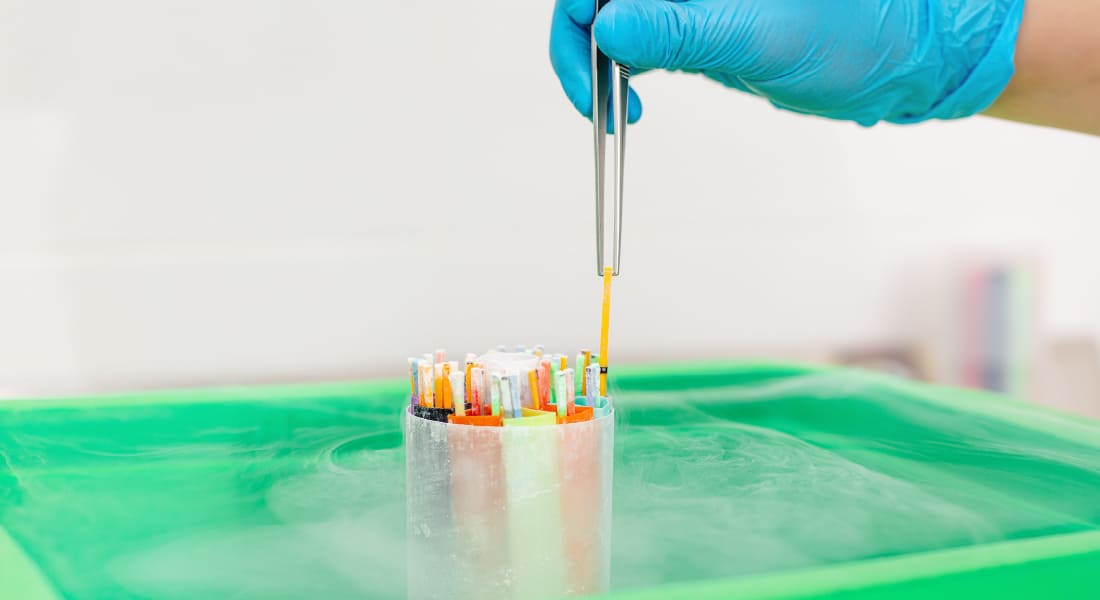Categories
The Benefits of Embryo Freezing
Jun 24, 2022
How is an embryo created?
To create and freeze an embryo, fertility specialists at BirthRight Fertility by Rainbow, the top fertility centre in Hyderabad, would harvest and fertilize eggs. First, the woman would take hormones to ensure that ovulation happens on schedule. Then, she would have to take fertility medications to increase the number of eggs that she will produce.
When ovulation would occur, fertility specialists would use an ultrasound machine to accurately extract the mature eggs. These eggs can either be used to become pregnant or be frozen.
Why is embryo freezing done?
There can be various reasons why a man and a woman would choose to freeze and store their embryos, including:
It can be a backup option if the IVF process doesn’t work for the first time.
The frozen embryos can be used later to have another child if the man and woman have a baby.
If the woman has cancer or some other disorder for which she might begin treatments that might reduce her chances of getting pregnant, she can save the embryos for later.
It might seem like a better option than the extra embryos getting destroyed.
The embryos could be saved and given to someone else in a donor program or be donated for research.
How is embryo freezing done?
Since embryos are frozen for later use, it is important to prevent the cells from bursting due to the water within the cells freezing and forming crystals. Cryopreservation involves replacing the water inside the cells with a cryoprotectant, which helps prevent the cell from bursting. Once the cryoprotectant is inserted, the fertility specialists leave the embryos to incubate in increasing levels of cryoprotectant before they are frozen.
After most of the water is removed, the embryos are cooled to their preservation state. The egg freezing process in Hyderabad at BirthRight Fertility by Rainbow can be done by two methods:
Slow freezing – In this process, the embryos are placed in sealed tubes and their temperature is then slowly lowered. This reduces the risk of damage and prevents the cells of the embryos from ageing.
Vitrification – Vitrification involves freezing the cryoprotected embryos so quickly that the water molecules don’t get time to form ice crystals. With this, the embryos are protected and their rate of survival during thawing increases.
In recent years, vitrification has been used more increasingly due to its benefits over slow freezing, which is time-consuming and requires expensive machinery. With vitrification, the risk of cell damage is low.
Embryo freezing is generally done one to six days after the embryos are created. Once the freezing process is complete, the embryos are stored in liquid nitrogen. They can be frozen for many years however it isn’t exactly known how long embryos can be frozen safely and still be useful.
What are the advantages of embryo freezing?
There are various benefits of embryo freezing, such as:
Multiple chances for pregnancy – If the first IVF cycle fails and if you have the additional frozen embryos from the first cycle, these embryos can be utilized and you wouldn’t have to go through the intensive hormone injection treatment all over again.
Delayed pregnancy – Generally, women's fertility typically peaks in their late 20s and remains so until the age of 35. However, for some, this might not be the age when they want to start their family. For these women, embryo freezing is a great option if they want to have children down the road using their healthiest embryos.
Increased progesterone levels – In some women, ovarian stimulation medications can cause progesterone levels to increase to a critical level which makes their uterus less receptive for embryo implantation. In such cases, embryo freezing is highly beneficial as instead of fresh embryo transfers, frozen embryos can be used in IVF cycles.
Ovarian hyperstimulation syndrome (OHSS) – In patients with OHSS, embryo freezing and frozen embryo transfer is recommended over fresh embryo transfers.
Genetic conditions – Embryo freezing helps with preimplantation genetic diagnosis (PGD), wherein embryologists would test each embryo for the genetic mutation if there is a risk of couples passing certain genetic conditions to their children.
Less risk of multiple pregnancies – With embryo freezing and frozen embryo transfers, the risk of multiple pregnancies is less as fewer embryos are transferred in a fresh cycle.
To create and freeze an embryo, fertility specialists at BirthRight Fertility by Rainbow, the top fertility centre in Hyderabad, would harvest and fertilize eggs. First, the woman would take hormones to ensure that ovulation happens on schedule. Then, she would have to take fertility medications to increase the number of eggs that she will produce.
When ovulation would occur, fertility specialists would use an ultrasound machine to accurately extract the mature eggs. These eggs can either be used to become pregnant or be frozen.
Why is embryo freezing done?
There can be various reasons why a man and a woman would choose to freeze and store their embryos, including:
It can be a backup option if the IVF process doesn’t work for the first time.
The frozen embryos can be used later to have another child if the man and woman have a baby.
If the woman has cancer or some other disorder for which she might begin treatments that might reduce her chances of getting pregnant, she can save the embryos for later.
It might seem like a better option than the extra embryos getting destroyed.
The embryos could be saved and given to someone else in a donor program or be donated for research.
How is embryo freezing done?
Since embryos are frozen for later use, it is important to prevent the cells from bursting due to the water within the cells freezing and forming crystals. Cryopreservation involves replacing the water inside the cells with a cryoprotectant, which helps prevent the cell from bursting. Once the cryoprotectant is inserted, the fertility specialists leave the embryos to incubate in increasing levels of cryoprotectant before they are frozen.
After most of the water is removed, the embryos are cooled to their preservation state. The egg freezing process in Hyderabad at BirthRight Fertility by Rainbow can be done by two methods:
Slow freezing – In this process, the embryos are placed in sealed tubes and their temperature is then slowly lowered. This reduces the risk of damage and prevents the cells of the embryos from ageing.
Vitrification – Vitrification involves freezing the cryoprotected embryos so quickly that the water molecules don’t get time to form ice crystals. With this, the embryos are protected and their rate of survival during thawing increases.
In recent years, vitrification has been used more increasingly due to its benefits over slow freezing, which is time-consuming and requires expensive machinery. With vitrification, the risk of cell damage is low.
Embryo freezing is generally done one to six days after the embryos are created. Once the freezing process is complete, the embryos are stored in liquid nitrogen. They can be frozen for many years however it isn’t exactly known how long embryos can be frozen safely and still be useful.
What are the advantages of embryo freezing?
There are various benefits of embryo freezing, such as:
Multiple chances for pregnancy – If the first IVF cycle fails and if you have the additional frozen embryos from the first cycle, these embryos can be utilized and you wouldn’t have to go through the intensive hormone injection treatment all over again.
Delayed pregnancy – Generally, women's fertility typically peaks in their late 20s and remains so until the age of 35. However, for some, this might not be the age when they want to start their family. For these women, embryo freezing is a great option if they want to have children down the road using their healthiest embryos.
Increased progesterone levels – In some women, ovarian stimulation medications can cause progesterone levels to increase to a critical level which makes their uterus less receptive for embryo implantation. In such cases, embryo freezing is highly beneficial as instead of fresh embryo transfers, frozen embryos can be used in IVF cycles.
Ovarian hyperstimulation syndrome (OHSS) – In patients with OHSS, embryo freezing and frozen embryo transfer is recommended over fresh embryo transfers.
Genetic conditions – Embryo freezing helps with preimplantation genetic diagnosis (PGD), wherein embryologists would test each embryo for the genetic mutation if there is a risk of couples passing certain genetic conditions to their children.
Less risk of multiple pregnancies – With embryo freezing and frozen embryo transfers, the risk of multiple pregnancies is less as fewer embryos are transferred in a fresh cycle.











